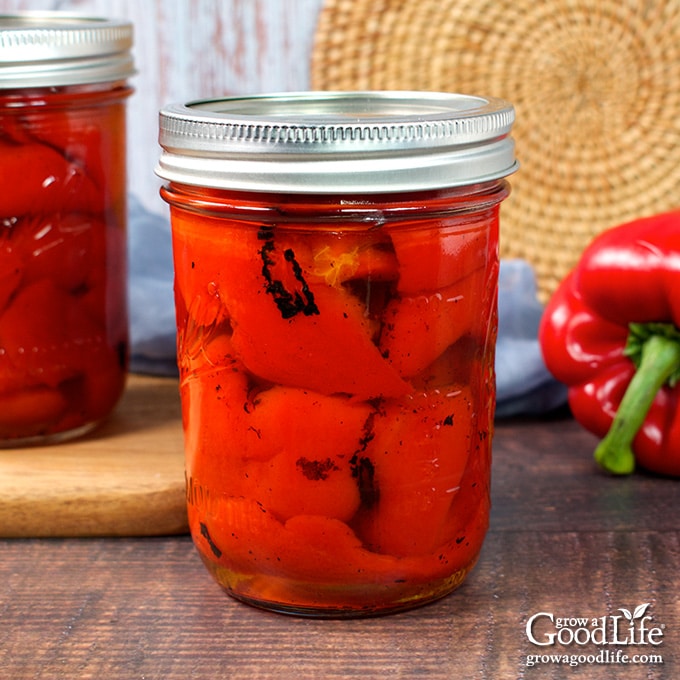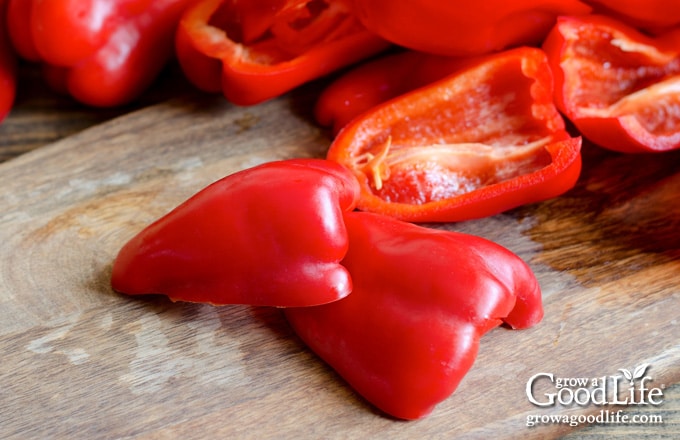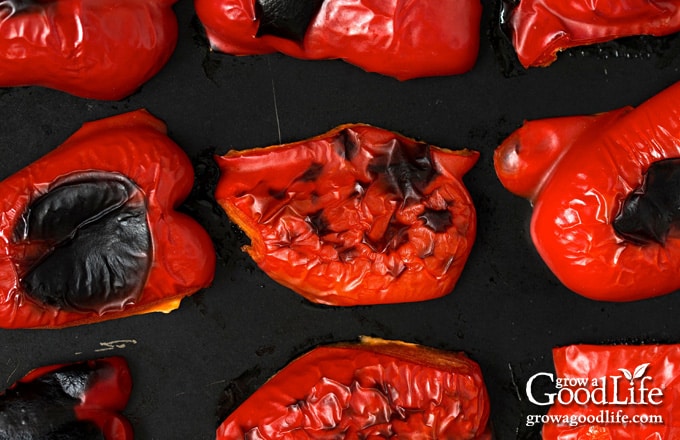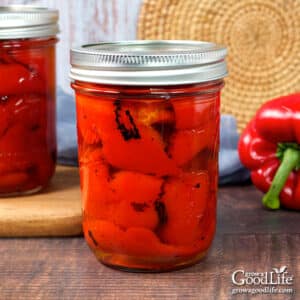How to Can Roasted Bell Peppers
This post may contain affiliate links, which means that I may receive a commission if you make a purchase using these links. As an Amazon Associate I earn from qualifying purchases.
Learn how to preserve the bounty of your homegrown sweet peppers with our step-by-step guide to canning roasted bell peppers. Enjoy that garden-fresh goodness all year long!

Whether your garden has yielded a bountiful harvest or you’ve stocked up at your local farmers market, pressure canning peppers is a delicious way to preserve them into shelf stable jars.
This guide will take you through the process of preserving roasted bell peppers so you can enjoy them long after harvest season ends.
Sweet Pepper Varieties for Pressure Canning
We are using red bell peppers for this recipe, but this pressure canning technique can be used to preserve all pepper varieties. Feel free to use your favorite type or customize your own unique pepper mixture:
- Classic Sweet Bell Peppers: Available in various colors, from green unripe peppers to red, yellow, orange, and purple when ripe. Their mild sweetness and thick walls make them an ideal choice for pressure canning.
- Banana Peppers: Yellow, long, and tapered shaped peppers that adds a mild, tangy sweetness to any dish.
- Cubanelle Peppers: Recognizable by their tapered shape and light yellowish-green color that ripens to bright red. The flavor is sweet, but they can have a touch of heat. Wear gloves when handling hot peppers.
- Italian Sweet Peppers: These peppers are elongated, like the Cubanelle, but often have a deeper, almost fruity flavor.
- Marconi Peppers: These long Italian sweet peppers can be found in red, yellow, or orange shades. They offer a sweet and mildly fruity taste that lends itself well to recipes.
- Jimmy Nardello Peppers: With their slender shape and reddish hue, these Italian frying peppers offer a sweet, mild spicy flavor that intensifies when roasted. Pressure canning maintains their flavor and transforms them into a pantry treasure.
- Pimento Peppers: These heart-shaped peppers boast a rich, sweet taste. Their thick walls are perfect for canning. Pressure canning preserves their distinctive flavor and texture.
Steps for Canning Roasted Bell Peppers
Since we are canning plain peppers, you’ll need to use a pressure canner to preserve them safely. Pressure canners processes at a high temperature necessary to eliminate the risk of food-borne bacteria. If you don’t have a pressure canner, you can freeze peppers after roasting. Check out the following article: How to Freeze Peppers.
If you are new to canning or haven’t canned in a while, reviewing this article on pressure canning at the National Center for Home Food Preservation website may be helpful, along with the instructions for your pressure canner.
This safe canning recipe is the “Peppers – Hot or Sweet” recipe from So Easy to Preserve and USDA Complete Guide to Home Canning books, and can be found on the NCHFP website. Please see the bottom of this article for a detailed and printable recipe. Here are the illustrated steps for roasting and canning bell peppers:
Step 1: Gather Your Kitchen Equipment
Collect your canning and kitchen equipment, prepare the jars and tools, and set up your work area.
You’ll need:
- Pressure canner with canning rack
- 8 pint-sized canning jars, or 16 half-pint jars
- Canning lids and bands (new lids for each jar, bands can be reused)
- Canning tools: jar lifter, canning ladle, funnel, and bubble popper
- Basic kitchen supplies including a knife, cutting board, large pot, large heatproof prep bowl, tongs, sheet pans, and clean kitchen towels.
Wash your canning jars, lids, bands, and tools with warm, soapy water and rinse well. Look the jars over carefully, and eliminate any that are damaged.
Get the pressure canner ready by inserting the canning rack and placing it on a large burner of your stove. Add water per your pressure canner manufacturer’s instructions: Presto is 3 quarts, Mirro is 2 quarts, and All American is 2 to 3 inches.
Fill the clean jars halfway with hot water, then place them on the rack in the canner. Fill a large pot with fresh water and put it on the stove. This is the water you will use to fill your jars of peppers.
It will take some time to prep your peppers, so you can heat the canner and jars and boil the pot of water later once the peppers are roasting in the oven.
Step 2: Prepare the Peppers
Give the bell peppers a thorough rinse under cold water, and pat them dry with a clean towel.
Cut each pepper in half, and remove the stem, seeds, and white membranes. Small peppers can be left in halves, but large peppers can be cut into quarters so that each piece is roughly the same size for even broiling. Place peppers on a baking pan, skin-side up.

Adjust your oven rack to be about 4 inches below the broiler element, and heat your oven to the broil setting. Slide the sheets under the broiler and roast for 6-8 minutes or until the skins blister and blacken.
Alternatively, you can fire roast your peppers on the grill. Just follow this tutorial: How to Roast and Peel Peppers.

Once the peppers are charred, remove the baking sheets from the hot oven. Use tongs to transfer the hot peppers to a heatproof bowl, and then cover it with your baking sheet or foil to trap in steam.
Let the peppers steam in the covered container for about 10 minutes. The steam will help loosen the skin, making it easier to peel. After steaming, uncover the bowl and use your fingers to pinch off the blistered skin. It should come off easily. Don’t worry about removing every bit; a little char adds to the flavor.
Step 3: Fill the Jars
While the peppers are steaming, bring the canner to a simmer (180˚F), and warm the jars for at least 10 minutes, and keep them warm.
Bring your large pot of water to a boil. This is the water you will use to fill your jars of peppers.
Spread a dry towel on the counter. Use the jar lifter to remove a jar from the canner. Pour out the water (save it for washing dishes), and place the jar on the towel. Keep the remaining jars in the canner so they stay hot.
Fill the jar with the prepared roasted peppers, packing them in loosely. If you are using salt, add up to a 1/2 teaspoon of salt to each pint jar and 1/4 teaspoon salt per half-pint.
Then, use the ladle to fill the jar with boiling water, leaving a 1-inch headspace at the top. Run the bubble popper through the jar to release any air bubbles, and adjust the headspace again if needed.
Wipe the rim with a damp towel to remove any residue. Center a lid on the jar, place the band over it, and screw it on until fingertip tight. Place the jar back into the canner and repeat with the rest of the jars.
Step 5: Process in a Pressure Canner
Once the filled jars are in the canner, follow your pressure canner’s instructions for sealing, venting, and heating, then process the jars for the times indicated in the recipe below.
When the processing time is complete, turn off the heat and let the canner cool. Then, open the canner, remove the jars, and place them on a towel. Keep them upright, and don’t tighten bands or check the seals yet. Let the jars sit undisturbed to cool and seal for 12 to 24 hours.
After the cooling period, test the seals and refrigerate any that failed to seal and use up in a few days. Before storing your jars, remove the rings and wash them thoroughly with soapy water to eliminate any residue. Then label, date, and find a cool spot to store them. Use your jars of roasted bell peppers within 12 to 18 months for optimal flavor.

Ways to Enjoy Your Roasted Peppers in a Jar
You’ll find plenty of uses for this pantry ingredient. Here are some delicious ways to make the most of jars of roasted bell peppers:
- Antipasto Platter: Arrange roasted bell peppers alongside olives, cheeses, cured meats, and crusty bread for a delightful antipasto platter bursting with flavors and colors.
- Pasta Toppings: Toss chopped roasted bell peppers into your favorite pasta dishes for added texture, sweetness, and a pop of color. They pair exceptionally well with creamy sauces.
- Hummus and Dips: Blend roasted bell peppers into hummus or other dips for a vibrant twist on your favorite spreads. They lend a unique flavor and captivating hue. Try adding to this Roasted Garlic White Bean Dip recipe.
- Sandwich Boost: Layer roasted bell peppers on sandwiches, wraps, and paninis to elevate the taste and provide a satisfying crunch. They’re an excellent addition to both cold and grilled sandwiches.
- Soups and Stews: Add chopped roasted bell peppers to soups and stews for additional sweet and smoky flavor.
- Pizza Perfection: Top your homemade pizzas with sliced or diced roasted bell peppers. Their smoky sweetness adds depth to the flavor profile of your pizza creations.
- Salad Accents: Add chopped roasted bell peppers to salads for an extra layer of flavor and texture. They complement leafy greens, grains, and protein-based salads alike.
- Omelets and Scrambles: Mix chopped roasted bell peppers into your morning omelets or scrambled eggs to infuse them with a burst of color and sweetness.
- Tacos and Burritos: Add roasted bell peppers to enhance your tacos, burritos, and quesadillas. They add a touch of smokiness that perfectly complements Mexican-inspired dishes.

Roasted Red Peppers Canning Recipe
Ingredients
- 8 pounds bell peppers or peppers of choice
- canning salt optional for flavor
Instructions
Prepare the Peppers
- Wash the bell peppers under cold water, then dry them with a clean towel.
- Cut each pepper in half and remove the stem, seeds, and white parts. Cut them into quarters so they’re about the same size. Place the peppers on baking pans with the skin facing up.
- Set your oven’s rack about 4 inches below the broiler and turn on the broil setting. Put the pans with peppers under the broiler and cook for 6 to 8 minutes or until the skins are charred and blackened.
- Take out the pans when the peppers are charred. Use tongs to move the hot peppers to a heatproof bowl and cover it with a baking sheet or foil to trap steam.
- Let the peppers sit in the covered bowl for 10 minutes. The steam will make the skin easier to peel.
- After steaming, uncover the bowl and use your fingers to remove the charred skin—it should come off easily. Don’t worry if some bits remain; they add flavor.
Prepare the Canning Equipment
- Wash the jars, lids, bands, and canning tools in hot, soapy water. Rinse them well. Set the lids and bands aside for later.
- Put the jar rack into the pressure canner and add water per your canner’s instructions: 3 quarts for Presto, 2 quarts for Mirro, and 2 to 3 inches for All American.
- Fill the jars halfway with hot water and put them on the rack in the canner. Let the canner simmer for 10 minutes at 180˚F. Keep it hot until you’re ready to fill the jars.
- Get a big pot of clean water boiling on the stove.
Fill the Jars
- Lay a dry towel on the counter. Use the jar lifter to take out a jar from the canner. Pour out the water (save it for washing dishes) and place the jar on the towel. Leave the other jars in the canner so they stay warm.
- Fill the jar loosely with the roasted peppers. If you are using salt, add up to a 1/2 teaspoon of salt to each pint jar, and 1/4 teaspoon salt per half-pint. Leave a 1-inch headspace.
- Use the ladle to pour hot water over the peppers until the jar is filled, maintaining a 1-inch space at the top.
- Slide a bubble popper through the jar to release air bubbles. If needed, add more water to maintain the 1-inch space, and wipe the rim clean.
- Center a lid on the jar, and screw on the band until it is fingertip tight.
- Use the jar lifter to put the jar back into the pressure canner. Repeat this for the rest of the jars.
Process in a Pressure Canner
- Cover the pressure canner and make sure the lid is secure. Keep the vent open.
- Set the heat to medium-high and let the canner come to a boil. Allow the steam to vent for 10 minutes.
- Put the pressure regulator on the air vent. Keep an eye on the pressure; it should rise.
- Once the canner reaches the correct pressure (10 pounds for weighted gauge and 11 pounds for dial gauge canners), start a timer.
- Process half-pint and pint jars for 35 minutes if you’re below 1,000 ft in altitude. Follow your canner’s instructions, keep the heat steady, and adjust for altitude if necessary (see notes).
- When the time’s up, turn off the heat. Let the canner cool down to 0 pressure on its own. After depressurizing, wait another 10 minutes before opening the lid.
- Spread a dry towel on the counter, unlock the cover, and remove the lid by tilting it away so that steam does not burn your face.
- Allow another 10 minutes to adjust to the change in pressure. If the jars are still boiling, leave them in the canner for 5 more minutes or until the boiling slows.
- Take the jars out with the jar lifter and place them on the towel. Keep them upright and don’t tighten the bands or check the seals yet. Let them sit untouched for 12 to 24 hours to cool down.
- After 12 to 24 hours, check if the lids have sealed by pressing the center. It shouldn’t pop up. If it does, it didn’t seal. Put the jar in the fridge and use it in a few days.
- Remove the screw-on bands and wash the jars. Label and date them, and store them in a cool, dark place. Use within 12 to 18 months for the best quality. This makes about 8 pint jars, or 16 half-pints of roasted red peppers.
Notes
- Dial-Gauge Canner Pressure (PSI) at Altitudes of 0 – 2,000 feet = 11 pounds, 2001 – 4,000 = 12 pounds, 4,001 – 6,000 = 13 pounds, 6,001 – 8,000 = 14 pounds.
- Weighted-Gauge Canner Pressure (PSI) at Altitudes of 0 – 1,000 feet = 10 pounds, above 1,001 feet = 15 pounds.
Nutrition
From Garden to Jar: More Recipes for Canning Peppers
Need more ideas to preserve an abundant pepper harvest? Explore some of our other recipes for canning peppers:
- Pickled Marinated Roasted Red Peppers: Sweet red peppers are roasted and then preserved in a pickle brine of red wine vinegar and olive oil, infused with zesty lemon juice, aromatic garlic, and fragrant oregano. It is an exquisite blend of flavors ideal for water bath canning.
- Candied Jalapenos (AKA Cowboy Candy): This pickled peppers recipe transforms jalapenos into a harmonious blend of sweetness and heat and is preserved in shelf-stable jars with a water bath canner.
- How to Can Green Chili Peppers: If you have an abundance of Anaheim, Hatch, New Mexico, or other hot peppers, follow this guide to roast, peel, and preserve their mild heat with this pressure canning recipe, ensuring you enjoy their goodness year-round.
- Canning Pickled Jalapeños: Elevate your pantry with the zesty kick of pickled jalapeño peppers. This water bath canning recipe transforms fresh jalapeno slices into tangy and spicy pickled peppers that are perfect for adding to sandwiches, nachos, and more.
40+ Meals in a Jar Pressure Canning Recipes
In this eBook, you will find 50 pressure canning recipes, including 44 meals, along with homemade stocks and bone broths. Recipes include soups, stews, chilis, beans, beef, pork, and poultry. Explore the world of preserving delicious home-cooked meals for all seasons.


Hi Rachel, I would like to can the pepper in a wide mouth half pint jar. My question is I will be using a Presto pressure canner and it is recommend to fill with three quarts of water, my half pint jars will or almost will be covered in water. Is that ok? and can I use another insert and double stack the jars? Jennifer
Hi Jennifer, Yes, it’s perfectly fine if your half-pint jars are almost fully submerged in the water during pressure canning. As for stacking, you can definitely double-stack your jars with another canning rack insert in between to ensure proper circulation.